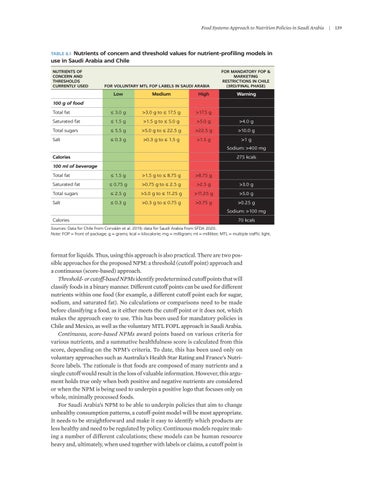Food Systems Approach to Nutrition Policies in Saudi Arabia
TABLE 8.1 Nutrients of concern and threshold values for nutrient-profiling models in use in Saudi Arabia and Chile NUTRIENTS OF CONCERN AND THRESHOLDS CURRENTLY USED
FOR VOLUNTARY MTL FOP LABELS IN SAUDI ARABIA
FOR MANDATORY FOP & MARKETING RESTRICTIONS IN CHILE (3RD/FINAL PHASE)
Low
Medium
High
Warning
Total fat
≤ 3.0 g
>3.0 g to ≤ 17.5 g
>17.5 g
Saturated fat
≤ 1.5 g
>1.5 g to ≤ 5.0 g
>5.0 g
>4.0 g
Total sugars
≤ 5.5 g
>5.0 g to ≤ 22.5 g
>22.5 g
>10.0 g
Salt
≤ 0.3 g
>0.3 g to ≤ 1.5 g
>1.5 g
100 g of food
>1 g Sodium: >400 mg
Calories
275 kcals
100 ml of beverage Total fat
≤ 1.5 g
>1.5 g to ≤ 8.75 g
>8.75 g
Saturated fat
≤ 0.75 g
>0.75 g to ≤ 2.5 g
>2.5 g
>3.0 g
Total sugars
≤ 2.5 g
>5.0 g to ≤ 11.25 g
>11.25 g
>5.0 g
Salt
≤ 0.3 g
>0.3 g to ≤ 0.75 g
>0.75 g
>0.25 g Sodium: >100 mg
Calories
70 kcals
Sources: Data for Chile from Corvalán et al. 2019; data for Saudi Arabia from SFDA 2020. Note: FOP = front of package; g = grams; kcal = kilocalorie; mg = milligram; ml = milliliter; MTL = multiple traffic light.
format for liquids. Thus, using this approach is also practical. There are two possible approaches for the proposed NPM: a threshold (cutoff point) approach and a continuous (score-based) approach. Threshold- or cutoff-based NPMs identify predetermined cutoff points that will classify foods in a binary manner. Different cutoff points can be used for different nutrients within one food (for example, a different cutoff point each for sugar, sodium, and saturated fat). No calculations or comparisons need to be made before classifying a food, as it either meets the cutoff point or it does not, which makes the approach easy to use. This has been used for mandatory policies in Chile and Mexico, as well as the voluntary MTL FOPL approach in Saudi Arabia. Continuous, score-based NPMs award points based on various criteria for various nutrients, and a summative healthfulness score is calculated from this score, depending on the NPM’s criteria. To date, this has been used only on voluntary approaches such as Australia’s Health Star Rating and France’s NutriScore labels. The rationale is that foods are composed of many nutrients and a single cutoff would result in the loss of valuable information. However, this argument holds true only when both positive and negative nutrients are considered or when the NPM is being used to underpin a positive logo that focuses only on whole, minimally processed foods. For Saudi Arabia’s NPM to be able to underpin policies that aim to change unhealthy consumption patterns, a cutoff-point model will be most appropriate. It needs to be straightforward and make it easy to identify which products are less healthy and need to be regulated by policy. Continuous models require making a number of different calculations; these models can be human resource heavy and, ultimately, when used together with labels or claims, a cutoff point is
|
139






